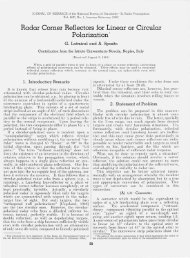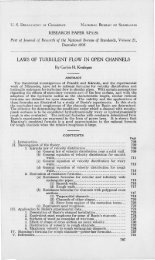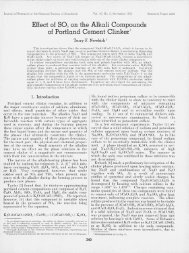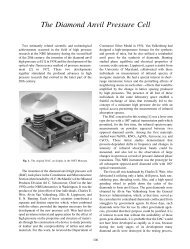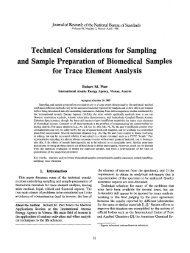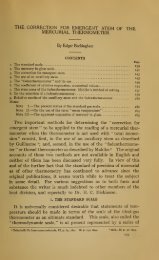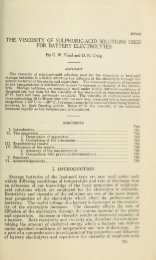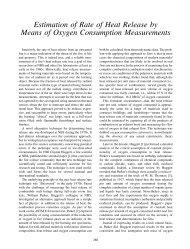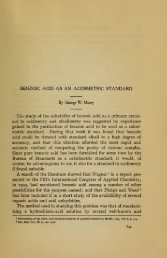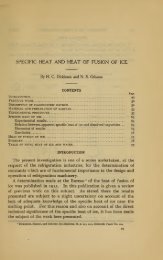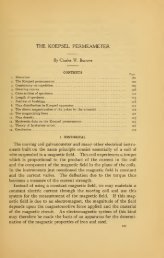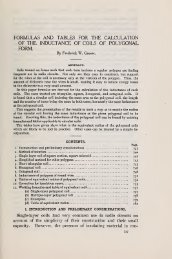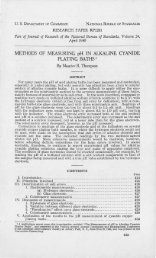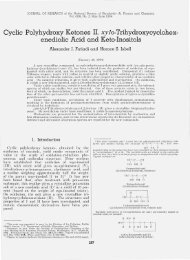Method for the separation of titanium, zirconium, iron ... - NIST Page
Method for the separation of titanium, zirconium, iron ... - NIST Page
Method for the separation of titanium, zirconium, iron ... - NIST Page
You also want an ePaper? Increase the reach of your titles
YUMPU automatically turns print PDFs into web optimized ePapers that Google loves.
JOURNAL OF RESEARCH <strong>of</strong> <strong>the</strong> National Bureau <strong>of</strong> Standards-A. Physics and Chemistry<br />
Vol. 64A, No. 6, November-December 1960<br />
<strong>Method</strong> <strong>for</strong> <strong>the</strong> Separation <strong>of</strong> Titanium, Zirconium, Iron,<br />
and Aluminum from One Ano<strong>the</strong>r and <strong>for</strong> <strong>the</strong>ir Subsequent<br />
Determination 1<br />
Thomas J. Murphy, W. Stanley Clabaugh, and Raleigh Gilchrist<br />
(Augu t 5, ] 960)<br />
A method is d c~c rib e d <strong>for</strong> t he se paration <strong>of</strong> t itan ium, zi rco nium, <strong>iron</strong>, and aluminum<br />
from one anothcr and <strong>for</strong> t heir subsequcnt determination . Iron is first precipitated with<br />
I - nit roso-2-naphthol after compJex ing t he <strong>titanium</strong> and <strong>zirconium</strong> with citrate to pre vent<br />
t heir prec ipitation. Titanium and <strong>zirconium</strong> are <strong>the</strong>n co llectivcly precipitated with cupferron<br />
and subsequent ly separated from each o<strong>the</strong>r by precipi tating t he titan ium wit h 8-hydroxyquinoline<br />
after co mplexing <strong>the</strong> <strong>zirconium</strong> wi th cthylcnecliaminetctraacet ic acid. A luminum<br />
and <strong>zirconium</strong> are r ecovcred from <strong>the</strong>ir r cs pective solut ion s by precipitation with cupfcrron .<br />
The accuracy <strong>of</strong> t he mcthod was p rovcd by analyzing syn<strong>the</strong>tic so lutions co ntaining<br />
known amounts <strong>of</strong> t he foul' clements.<br />
1. Introduction<br />
This paper describes <strong>the</strong> <strong>separation</strong> and determination<br />
<strong>of</strong> <strong>titanium</strong>, <strong>zirconium</strong>, <strong>iron</strong>, and aluminum<br />
in barium titanate ceramic dielectrics. These ceramic<br />
dielectrics may be dissolved by digestion on<br />
<strong>the</strong> steam bath overnight in a solu tion containing<br />
cqual volumes <strong>of</strong> hydrochloric acid and water. Any<br />
undissolved residue may be brought into solution<br />
by fu ing it with sodium carbonate and treating <strong>the</strong><br />
resulting fusion with diluted hydrochloric acid.<br />
Titanium, <strong>zirconium</strong>, <strong>iron</strong>, and aluminum can <strong>the</strong>n<br />
be sharply separated from <strong>the</strong> alkahne earths, <strong>the</strong><br />
alkalies, and silicon by a double precipitation with<br />
8-hydroxyqllinoline.<br />
The procedure described here starts with <strong>the</strong> collective<br />
precipitation <strong>of</strong> tbe four clement by 8-h ~T <br />
dwxyquinoline. Much <strong>of</strong> <strong>the</strong> analytical chemistry<br />
involvcd is new and should have application to<br />
analytical problems o<strong>the</strong>r than those <strong>of</strong> ceramic<br />
dielectrics.<br />
2 . Reagents<br />
Standard Titanium Solution: Fifty milliliters <strong>of</strong><br />
<strong>titanium</strong> tetrachloride, purified according to <strong>the</strong><br />
directions <strong>of</strong> Clabaugh, Leslie, and Gilchrist [1]/<br />
was slowly added to 100 ml <strong>of</strong> ice cold water. The<br />
resulting solution was diluted to 2.5 liters with diluted<br />
hydrochloric acid (1 + 1).3 Three 50-g portions<br />
<strong>of</strong> tbis diluted soluLio n, measured with a weight buret,<br />
were each diluted Lo 250 ml and t he <strong>titanium</strong> content<br />
I Financhl su pport <strong>of</strong> this work was furnished b y <strong>the</strong> Diamond Ordnance Fuze<br />
I ,aboratories, D epa rtment <strong>of</strong> tho . \ J'Ill~r, \Vashington 25, D.C.<br />
Z Figures in brackets indicate <strong>the</strong> literature rcferences at <strong>the</strong> end <strong>of</strong> this paper.<br />
3 " ' hen <strong>the</strong> lise <strong>of</strong> an acid is prescribed with no indication <strong>of</strong> strength or ciilution,<br />
<strong>the</strong> acid to be used is t he concentrated acid. Dilutions arc ind icated by t ho vol·<br />
urnes <strong>of</strong> acid and wator mixed to prepare a diluted r ca~c nt. Diluted h ydrochloric<br />
acid (1+x) means a diluted acid prepared by mixi ng 1 volume <strong>of</strong> <strong>the</strong> concentrated<br />
acid with x volumes <strong>of</strong> distilled water. Similar designations arc used <strong>for</strong> ammonium<br />
h ydroxide.<br />
535<br />
determined by precipitating with cupferron and<br />
igniting <strong>the</strong> precipitate to Ti0 2 •<br />
StandaTd hon Solution: About 20 g <strong>of</strong> ferric<br />
chloride hexahydrate, American Chemical Society<br />
Reagent grade, was dissolved in 200 ml <strong>of</strong> diluted<br />
hydro chloric acid (1 + 1). The resulting solution was<br />
diluted to 2 liters with water. The titer was<br />
determined in a manner similar to that <strong>for</strong> <strong>titanium</strong>.<br />
StandaTd Zirconium Solution: About 65 g <strong>of</strong> <strong>zirconium</strong><br />
sulfate tetrahydrate, purifLOd according to<br />
<strong>the</strong> procedure described by Clabaugh and Gilchrist<br />
[2], was dissolved in 1 liter <strong>of</strong> diluted hydrochloric<br />
acid (1 + 3) and tberesulting solution tben diluted t.o<br />
2 litcrs with diluted hydrochloric acid (1 + 3) . The<br />
titer was determined in a manner similar to tbat <strong>for</strong><br />
<strong>titanium</strong>. This titer also includes an y hafnium<br />
present in <strong>the</strong> <strong>zirconium</strong>.<br />
StandaTd Aluminum So .~ution: About 4 g <strong>of</strong> pure<br />
metallic alumLnum was dissolved in 400 ml <strong>of</strong> diluted<br />
hych'ocbloric acid (l + 2) and <strong>the</strong> resulting<br />
solution <strong>the</strong>n diluted to 2 liters with water. Three<br />
50-g portions <strong>of</strong> this diluted solution, measured<br />
with a weight buret, were each diluted to 250 mI.<br />
To each <strong>of</strong> <strong>the</strong>se solutions 10 ml <strong>of</strong> acetic acid was<br />
added. The acidity waf! <strong>the</strong>n reduced to value <strong>of</strong> pH<br />
5.0 with diluted ammonium hydroxide (1 + 1). The<br />
aluminum content was determined by precipitaLing<br />
with 8-h ydroxyquinoline and ig'niting <strong>the</strong> precipitate<br />
to A120 3•<br />
l-NitToso-2-Naphthol Reagent Solution: Commercially<br />
available samples <strong>of</strong> I-nitl'Oso-2-napb thol were<br />
found to contain significant amounls <strong>of</strong> residue on<br />
ignition. For three different samples <strong>the</strong> rcsidues<br />
amounted to 0.07 perce nt, 0. 14 perccnt, and<br />
0.19 percent. Spectrochemical e'\amin ation <strong>of</strong> one<br />
<strong>of</strong> <strong>the</strong> residues showed t hat it was primarily FC20 3,<br />
and also co ntained about 10 percenL each <strong>of</strong> MgO<br />
and Si02.<br />
Five ~rams <strong>of</strong> I-nitro so.-2-naph~hol was placed in<br />
a 25-ml porous porcclam fi ltenng cruclble and
leached with 800 ml <strong>of</strong> water heated to 60 °C. This<br />
treatment dissolved about 0.5 g <strong>of</strong> <strong>the</strong> reagent. Five<br />
hundread ml <strong>of</strong> dilu ted ethanol (1 + 1), heated to<br />
about 60 °C, was <strong>the</strong>n passed through <strong>the</strong> filter and<br />
this dissolved most <strong>of</strong> <strong>the</strong> water-washed material.<br />
The porcelain filter and residue were air-dried and<br />
weighed. The concentration <strong>of</strong> <strong>the</strong> reagent in <strong>the</strong><br />
alcoholic solution was determined by difference.<br />
This treatment reduced <strong>the</strong> residue on ignition from<br />
0.07 to 0.01 percent. This reagent solution must be<br />
jreshly prepared since it decomposes on standing.<br />
Oupjerron R eagent Solution: Five grams <strong>of</strong> cupferron,<br />
<strong>the</strong> ammonium salt <strong>of</strong> nitrosophenylhydroxylamine,<br />
was dissolved in 100 ml or water. This<br />
solution must be jreshly prepared since it decomposes<br />
on standing.<br />
Ammonium Acetate R eagent Solution: Five hundred<br />
milliliters <strong>of</strong> acetic acid was cooled in an ice<br />
bath and ammonium hydroxide was slowly added<br />
to <strong>the</strong> cold solution until <strong>the</strong> pH o( tll e resulting<br />
solution was 7. 4<br />
Ethlllenediaminetetraacetic Acid: To prepftl'C cthylenedia,minetetraacetic<br />
acid su itable r or use, tllC<br />
practical grade was dissolved in a solution 0[' ammonium<br />
hydroxide. This solution was fi ltered and<br />
<strong>the</strong>n neutralized to pH 1 wit h 11 ,\~droch lor i c acid to<br />
reprecipitate <strong>the</strong> ethylenedin,1l1 i ll eteLmacet ic acid.<br />
The precipitate was caugh t on a filtel', wi],sllCd well<br />
with distilled water, and dried at 100 °C.<br />
O<strong>the</strong>r Reagents: All <strong>the</strong> o<strong>the</strong>r reagents used con <br />
<strong>for</strong>med to <strong>the</strong> specifications <strong>of</strong> <strong>the</strong> American Chemical<br />
Society <strong>for</strong> reagent chemicals.<br />
3 . Development <strong>of</strong> <strong>the</strong> Procedure<br />
3 .1. Separation <strong>of</strong> Iron From Titanium, Zirconium,<br />
and Aluminum<br />
FeZ0 3, or 500 mg <strong>of</strong> ZrOz and 50 mg <strong>of</strong> Fe20 3, or<br />
500 mg <strong>of</strong> Al20 3 and 50 mg <strong>of</strong> Fe20a, <strong>the</strong> results were<br />
always high. This was thought to be due to <strong>the</strong><br />
fact that 1-nitroso-2-naphthol is not very soluble<br />
uncler <strong>the</strong>se conditions and that <strong>the</strong> ferric nitrosonaphtholate<br />
<strong>for</strong>ms so slowly that most <strong>of</strong> th e<br />
I-nitroso-2-naphthol precipitates from solution and<br />
adsorbs some <strong>of</strong> <strong>the</strong> metallic ions. Ethanol increased<br />
<strong>the</strong> solubility <strong>of</strong> 1-nitroso-2-naphthol and improved<br />
<strong>the</strong> <strong>separation</strong>, provided that <strong>the</strong> ethanol content<br />
did not exceed 75 ml <strong>of</strong> 95-percent ethanol in 350 ml<br />
<strong>of</strong> solution and provided that at least a 0.2-g excess <strong>of</strong><br />
1-nitroso-2-nitphthol was present. If more ethanol<br />
or less 1-nitroso-2-naphthol were present, <strong>the</strong> precipitation<br />
<strong>of</strong> <strong>iron</strong> was not complete.<br />
a. S"paration <strong>of</strong> Iron From Titanium<br />
Eight syn<strong>the</strong>tic mixtures <strong>of</strong> <strong>iron</strong> and <strong>titanium</strong><br />
were prepared from. <strong>the</strong> respective standard solutions.<br />
Each solution contained an amount <strong>of</strong> <strong>titanium</strong><br />
equivaJent Lo 500 mg <strong>of</strong> TiOz and an amollnt <strong>of</strong> <strong>iron</strong><br />
eq uivalent to from 0.2 mg to 50 mg <strong>of</strong> Fe Z03' T en<br />
grn,lll s <strong>of</strong> citric acid and 1.8 g oJ 8-hydroxyquinoline<br />
Wf'l'e added to each solution. The citric acid was<br />
fielded to co mplex <strong>the</strong> <strong>titanium</strong>. The 8-hydroxyquinoline<br />
was added to approximate th e amount<br />
or this reagent that would be presenL if <strong>the</strong> mixture<br />
wa,s first precipitated with 8-hydrox:rquinolin e to<br />
separate this group <strong>of</strong> clements from Lh e allmli es and<br />
alkalin e earths and <strong>the</strong>n taken into soluLion a<br />
described in section 4.1.<br />
The acidity <strong>of</strong> each solution was adjusted to pH<br />
1.5 with di.luted ammonium hydroxide (1+ 1), and<br />
<strong>the</strong>n th e <strong>iron</strong> was precipitated with 1-nitroso-2-<br />
naphthol reagent solution as described in section 4.2.<br />
The resul ts o( <strong>the</strong>se separaLions are given in table L<br />
Ferric <strong>iron</strong> is reported to be quantitatively precipitated<br />
by I-nitroso-2-naphthol, (ClOH 70 2N), in <strong>the</strong><br />
pH ran~e 0.95 to 2.00 [3]. The <strong>iron</strong> is precipitated<br />
as ferne nitrosonaphtholate [4], Fe (CIOH o0 2N)3,<br />
which can be ignited to ferric oxide [5], Fe:i0 3'<br />
Titanium and <strong>zirconium</strong> are also reported to precipitate<br />
with I-nitroso-2-naphthol from weak acid<br />
solutions [6]. Aluminum does not <strong>for</strong>m an insoluble<br />
precipitate with I-nitroso-2-naphthol.<br />
Citrate ion was found to prevent <strong>the</strong> precipitation<br />
<strong>of</strong> <strong>titanium</strong> and <strong>zirconium</strong> nitrosonaphtholates from<br />
weakly acid solution, at about pH 1.5. Ferric <strong>iron</strong><br />
was found to precipitate quantitatively from a<br />
citrate solution in <strong>the</strong> pH range 1.0 to 2.0. Siner,<br />
aluminum is not precipitated by 1-nitroso-2-naphthol,<br />
and since citrate ion prevents <strong>the</strong> precipitation <strong>of</strong><br />
<strong>titanium</strong> and <strong>zirconium</strong> , <strong>the</strong> possibility <strong>of</strong> separating<br />
<strong>iron</strong> from <strong>the</strong>se elements by <strong>the</strong> precipitation <strong>of</strong> ferric<br />
nitrosonaphtholate from a citrate solution was inves<br />
tiga ted.<br />
It was found that when precipitations <strong>of</strong> <strong>iron</strong> were<br />
attemp ted from solutions having a volume <strong>of</strong> about<br />
350 mi and containing 500 mg <strong>of</strong> Ti02 and 50 mg <strong>of</strong><br />
4 All pH measarements were made with a glass-electrode pIT meter.<br />
536<br />
TABLE 1.<br />
Hes1t1ts obtained in <strong>the</strong> separat';on oj tron fru ln<br />
titaniu1n by I-nitmso-2-naphthol<br />
Chemical a nalysis <strong>of</strong> 50 mg <strong>of</strong> Fe z0 3, separated<br />
from 500 mg or TiOz, showed that <strong>the</strong> Fe Z03 contained<br />
sli~htly more than 0.1 mg, but less than~O.2<br />
mg <strong>of</strong> TiOz.<br />
b . Separation <strong>of</strong> Iron From Zirconium<br />
Five syn<strong>the</strong>tic mixtures <strong>of</strong> <strong>iron</strong> ami <strong>zirconium</strong><br />
were prepared from <strong>the</strong> respective standard solutions.<br />
Each solution contained an amount <strong>of</strong> zir-
conium equivalent to 500 mg <strong>of</strong> Zr02 and an amount<br />
<strong>of</strong> <strong>iron</strong> equivalent to from 0.5 mg to 50 mg <strong>of</strong> F e20 a.<br />
The syn<strong>the</strong>tic mixture were treated exactly a<br />
<strong>the</strong> <strong>iron</strong>-<strong>titanium</strong> mixtures in secLion a, and <strong>the</strong> <strong>iron</strong><br />
in each solution was separated and determined by<br />
tho method de crib cd in eeLion 4.2.<br />
The resulLs <strong>of</strong> <strong>the</strong>se sepal'ations arc given in table<br />
2 .<br />
T ABLE 2.<br />
Re.
It was found, however, that if slightly less cnpferron<br />
than <strong>the</strong> amount necessary to precipitate<br />
completely <strong>the</strong> <strong>titanium</strong> or <strong>zirconium</strong> was added,<br />
and <strong>the</strong> solution heated to about 60 ° C and stirred<br />
continually, <strong>the</strong> precipitated cupferrates changed<br />
from a bulky, flo cculent <strong>for</strong>m to a dense and compact<br />
<strong>for</strong>m. The precipitation <strong>of</strong> ti tanium or <strong>zirconium</strong><br />
was <strong>the</strong>n completed by <strong>the</strong> slow addition <strong>of</strong> cupferron<br />
reagen t solution un til a permanent precipitate no<br />
longer <strong>for</strong>med . Fimllly, <strong>the</strong> solutions were cooled<br />
and an additional 10 ml <strong>of</strong> th e cupferron reagent<br />
solution was added to each.<br />
Figure 1 shows a comparison <strong>of</strong> <strong>the</strong> volumes <strong>of</strong><br />
eq ual amounts <strong>of</strong> <strong>titanium</strong> precipitated with cupferron<br />
by <strong>the</strong> normal method and by <strong>the</strong> revised<br />
method. Figure 2 shows a similar comparison in<br />
<strong>the</strong> case <strong>of</strong> <strong>zirconium</strong>. The amounts <strong>of</strong> ti tanium<br />
and <strong>of</strong> <strong>zirconium</strong> involved wer e equivalent to 500<br />
mg <strong>of</strong> <strong>the</strong>ir respec tive dioxides.<br />
F IGUR E 1. Com paTison <strong>of</strong> <strong>the</strong> volumes <strong>of</strong> equal amounts <strong>of</strong><br />
<strong>titanium</strong> preci pitated with cupfen'on by <strong>the</strong> normal method,<br />
it, and <strong>the</strong> Tevised metho d, B.<br />
It was reasoned thLtt since <strong>the</strong> volumes <strong>of</strong> <strong>the</strong><br />
precipitates were much smaller by <strong>the</strong> revised method<br />
<strong>of</strong> precipitation , a better <strong>separation</strong> <strong>of</strong> <strong>titanium</strong><br />
and <strong>zirconium</strong> from aluminum might be effected.<br />
Syn<strong>the</strong>tic mixtures containing 50 m g <strong>of</strong> Al 20 3 and<br />
500 mg <strong>of</strong> Ti02, and also mixtures containing 50<br />
mg <strong>of</strong> Ab03 and 500 mg <strong>of</strong> Zl'02, wer e prepared from<br />
<strong>the</strong> stand,u'd solutions. The <strong>separation</strong>s were<br />
effected by <strong>the</strong> revised procedure described above.<br />
The results, also r eported in table 4, show that <strong>the</strong><br />
amount <strong>of</strong> aluminum that was precipitated with <strong>the</strong><br />
<strong>titanium</strong> and <strong>zirconium</strong> was significantly reduced.<br />
3.3. Recovery and Determination <strong>of</strong> Aluminum<br />
Aluminum is reported to be quantitatively precipitated<br />
by cupferron from wealdy acid solution,<br />
probably as AI (C 6H 5N 20 2h This compound can<br />
be ignited to [10] Al20 3.<br />
The completeness <strong>of</strong> precipitation <strong>of</strong> aluminum<br />
by cupferron from a solution containing large<br />
amounts <strong>of</strong> ammonium chloride a nd ammonium<br />
citrate was determined by <strong>the</strong> analyses <strong>of</strong> foul'<br />
syn<strong>the</strong>tic solutions <strong>of</strong> aluminum containing from<br />
0.5 mg to 50 mg <strong>of</strong> Alz0 3 which were prepared from<br />
<strong>the</strong> standard solut ions. T en grams <strong>of</strong> citric acid<br />
and 50 ml <strong>of</strong> hydrochloric acid were added t o each<br />
solution a nd t he solutions were <strong>the</strong>n diluted to<br />
400 ml. The acidity <strong>of</strong> each solution was adjusted<br />
to pH 4.0 with ammonium hydroxide. Enough<br />
cupferron reagen t iOlolution was added to fmnish a<br />
1-g excess <strong>of</strong> cupferron. The solutions were allowed<br />
to stand overnight in a cold box. The precipitates<br />
were caught on 12 .5-cm papers, washed with a<br />
1-percent solution <strong>of</strong> cup ferron , and ignited t o<br />
Al20 3 in porcelain crucibles at 1,100 °c.<br />
The resul ts <strong>of</strong> <strong>the</strong>se determinations are given in<br />
table 5. In each instance <strong>the</strong> recovery <strong>of</strong> <strong>the</strong> added<br />
aluminum was complete.<br />
T AB L E 5.<br />
R ecovery oj aluminum by precipitation with<br />
cup/en'on<br />
Experimen<br />
t;<br />
Al um in um Oxide<br />
Artdcd Found Errol'<br />
mg<br />
0 .. ><br />
4.8<br />
23. 4<br />
51. 5<br />
mq<br />
0.5<br />
4. 7<br />
23.3<br />
51. 7<br />
mg<br />
0.0<br />
-.1<br />
-.1<br />
+.2<br />
FIGUR E 2. Com pa1'ison <strong>of</strong> <strong>the</strong> volumes <strong>of</strong> equal amounts <strong>of</strong><br />
zirconi1lm pTeci pitated with cupferron by <strong>the</strong> nonnal method,<br />
A, and <strong>the</strong> revised method, B.<br />
3.4. Separation <strong>of</strong> Titanium From Zirconium<br />
In weakly acid solution, ethylen ediamilletetr a<br />
acetic acid <strong>for</strong>ms a strong mole-to-mole complex<br />
with <strong>zirconium</strong> [11] and a weaker on e wit h <strong>titanium</strong><br />
[12] . Sen Sarma and Mallik [13] state that <strong>the</strong><br />
<strong>zirconium</strong> complex is strong enough t o preven t <strong>the</strong><br />
precipitation <strong>of</strong> <strong>zirconium</strong> by 8-hydroxyquinoline<br />
in weakly acid solution. E xperiments in our laboratory<br />
showed that <strong>titanium</strong> could be a1most completely<br />
precipitated as titanyl quinolate, TiO-<br />
538
(CgH 6NO)2·2H20, at pH 4.5 in <strong>the</strong> presence <strong>of</strong><br />
etbylenediaminetetraaceLic acid, under certain CO I1 -<br />
ciiLions. A I -g' excess <strong>of</strong> 8-1l yclroxyquinoline over<br />
t he amount necessary to precipiLate t he . LiLanyl<br />
qllinola Le must be present. The exce s <strong>of</strong> eLhylened<br />
iaminetetraacetic acid should not, bc grcater t han<br />
0.5 g over t he amoun L needeclLo complex th e<br />
zlrconium. Th e solu tion should be coolod in an ico<br />
bath be<strong>for</strong>e filLe ring. 'iiVhen t hese conditions are<br />
observed, t he amount <strong>of</strong> tiLan ium remaining i n<br />
solu tion was found Lo be abou L 0.05 mg as TiOz.<br />
This solubiliLy <strong>of</strong> <strong>titanium</strong> was low enough to rogard<br />
<strong>the</strong> prec ipiLation as complet.e .<br />
The Litanyl quinolate precipitate can . be decomposed<br />
by heat from an infrar ed lamp and co nverted<br />
to Ti02 by igni tion in an electric furnace. Berg and<br />
T eitelbaum [14] reporLod that this decomposition<br />
should be done under a layer <strong>of</strong> oxnlic acid, becau 0<br />
<strong>of</strong> <strong>the</strong> volatility <strong>of</strong> titanyl quinohtte. Ar end and<br />
Schnellenbach [15] used a direct decomposition and<br />
ignition <strong>of</strong> Litanyl quinolate without <strong>the</strong> addition <strong>of</strong><br />
oxalic acid . Experiments in our laboratory showed<br />
tlhlt whell Lhe decomposiLion was per<strong>for</strong>med with<br />
heflt from an infrared lamp, no titanyl quinola,te<br />
was volatilized. Known amounts <strong>of</strong> <strong>titanium</strong> werc<br />
precipitaLed by 8-hyd roxyq uinolino, docomposed b~r<br />
hel1 t from an infrared lamp, and ignited to Ti02<br />
\vithout any loss <strong>of</strong> LiLanium. No Ln1ce <strong>of</strong> titflll ium<br />
was found when Ul e decomposition products from<br />
hcating ti tanyl q uinolate wi tlt an infntredlamp wero<br />
passed through :1 solu tion <strong>of</strong> sulfuric acid.<br />
Syn <strong>the</strong>tic solutions containing from 475 mg <strong>of</strong><br />
1'i0 2 ,1nd 25 mg <strong>of</strong> Zr02 to 100 mg <strong>of</strong> Ti02 and 400<br />
mg <strong>of</strong> Zr02 were prep,ued from <strong>the</strong> st,1l1cial'd solutions.<br />
These mixtures were converted to suUtltes bv<br />
<strong>the</strong> addition <strong>of</strong> ]5 ml <strong>of</strong> sulfuric aciel and subsequOll t<br />
evapora lion Lo fumes <strong>of</strong> sulfuri c acid. E ach solu tion<br />
was LhCll tre,tted ,tS described ill section 4.5. E,tch<br />
prec ipi t.'1te <strong>of</strong> t i t ~1nyl qu inolate was dissolved in 100<br />
ml <strong>of</strong> diluted sulfuric acid (15+ 85) and t he <strong>titanium</strong><br />
reprecipi tated. To determine <strong>the</strong> conta,mination <strong>of</strong><br />
Lhe first precipi tate by <strong>zirconium</strong>, <strong>the</strong> filtrates from<br />
th e seco nd precipitation were made acid with ltydrocJllori<br />
c acid and <strong>the</strong> zirconi urn recovered by precipitation<br />
with cupferron. The solutions were allowed<br />
to stand <strong>for</strong> about 4 hI' and filtered through 9-cm<br />
papers. The filters and precipitates were washed<br />
with a solution <strong>of</strong> eupferron, tr ansferred to porcehlin<br />
crucibles, decomposed by an infmred lamp, and<br />
ignited to Zr02 at 1000 DC.<br />
The degree <strong>of</strong> contamination <strong>of</strong> <strong>the</strong> titanyl quin()<br />
late b~r <strong>zirconium</strong>, over <strong>the</strong> range studied, is given<br />
in table 6.<br />
The separ ation was satisfn,ctory up to <strong>the</strong> con<br />
centration range <strong>of</strong> about 200 mg or Ti02 and 300<br />
mg <strong>of</strong> Zr02' For amounts or <strong>zirconium</strong> in excess<br />
<strong>of</strong> this amount a double precipitation should b e<br />
made, bu t this increases <strong>the</strong> amount <strong>of</strong> soluble <strong>titanium</strong><br />
weighed wi th <strong>the</strong> Zr02 to 0.1 mg <strong>of</strong> Ti02.<br />
Eight syn <strong>the</strong> tic mixtureS <strong>of</strong> <strong>titanium</strong> and <strong>zirconium</strong><br />
were prepared from <strong>the</strong> standard solutions. Fifteen<br />
milliliters <strong>of</strong> sulfuric acid was added to each and th e<br />
562312- 60--7 539<br />
TAR Lg 6.<br />
Rxperiments whirh show <strong>the</strong> de(f1'ee 0/ contaminetlion<br />
0/ titaniuJn quino/ate by zirconiwn<br />
Expcril1l<br />
('ni<br />
-<br />
TiO, ZrO, ZrO,found<br />
in Ti<br />
prC'ci pitaLe<br />
.\deled Added<br />
7ng rnq 'lny<br />
1 475 25 0. 0<br />
2 450 50 .0<br />
~ 425 75 .0<br />
4 400 100 . 1<br />
5 ~oo 200 .2<br />
(l 200 300 .1<br />
7 100 400 .4<br />
solutions were evaporated to [urnes <strong>of</strong> sulfuri c acid.<br />
The <strong>titanium</strong> was <strong>the</strong>n separated and detennined by<br />
<strong>the</strong> procedure described ill section 4.5. The filtri1tes<br />
were reserved <strong>for</strong> <strong>the</strong> determinatlOll <strong>of</strong> <strong>zirconium</strong><br />
according to Llle directions in sec Lion 3.5. The resill<br />
ts <strong>of</strong> tlle'se <strong>separation</strong>s and detenui n,.Lions aro<br />
given in Lable 7.<br />
T A lHB 7. R esults obtained in <strong>the</strong> se pw'ation <strong>of</strong> <strong>titanium</strong> F OIn<br />
ziTconiwn by prec'ipita!ioT/, with 8-hyrtJ'oxyq1tinoline in a<br />
solution conta'inin(J elh ylenedia1m:netetmacetic acid<br />
Experi -<br />
ment Ko.<br />
----<br />
Titanium dioxide<br />
Zirroniu m dioxido<br />
Addecl Founcl E IT OI' Added Found Errol'<br />
q my mo<br />
I O. 5037 0.5037 0.0 0.0005 0.0006 + 0. 1<br />
2 .4981 .4984 +3 .0009 .0009 .0<br />
3 .4831 .4830 - . 1 .0067 .0066 - . 1<br />
'1- .4808 . 4809 + 1 .0093 . 0092 - . 1<br />
5 .4605 . 4008 +3 .0268 .0268 .0<br />
6 __ - .-.-.-- . 44 68 . 4471 +3 .0606 . 0604 - .2<br />
7 .3941 . 3944 +3 . 10~5 . 1035 .0<br />
8 - - .------ .2905 .2907 +2 . 2185 .2185 . 0<br />
3.5. Recovery and Determination <strong>of</strong> Zirconium<br />
Majumdar and Chowdhury [16] reported that, ill<br />
Lh e presence <strong>of</strong> ethylenediaminetetraacetic acid,<br />
<strong>zirconium</strong> can be quantitatively precipitated by<br />
cupferron from. hydrochloric acid solu tion.<br />
ero co nfirm this observation, five solutions COJltaining<br />
known amounts <strong>of</strong> <strong>zirconium</strong> in <strong>the</strong> range or<br />
0.5 mg to 55 mg <strong>of</strong> Zr02 were prepared. Fifteen<br />
milliliters <strong>of</strong> sulfuric acid was added to each solution<br />
and enough ethylenediaminetetraacetic acid to furnish<br />
a 0.5-g excess over <strong>the</strong> amount necessary to<br />
cornplex <strong>the</strong> <strong>zirconium</strong>. The acidity <strong>of</strong> each solution<br />
was adjusted to pH 1.5 with ammonium. hydroxidc,<br />
and <strong>the</strong>n to pH 4.5 wi th <strong>the</strong> amrnonium acetate<br />
reagent solution. F ifty milliliters <strong>of</strong> hydrochloric<br />
acid was added to each solution and enough cup<br />
[elTon to furnish an excess <strong>of</strong> 1 g. The solutions<br />
were aHowed to stand overnight in a cold box, <strong>the</strong>n<br />
fil tered through 12.5-cm papers. '1'he fil ters ttnd<br />
precipitates were decomposed in porcelain crucibl es,<br />
and ignited to Zr02'<br />
'rhe res ults are given in table 8.
Recovery <strong>of</strong> z'irconiurn by precipitation with cup<br />
Jerron in a s()tvtwn containing ethylenediaminetetraacetic<br />
aC 1:d<br />
TABLE 8.<br />
Zirconium dioxide<br />
E~~~'t I---~---~---<br />
Added Found Errol'<br />
my I fUj my<br />
L ________ 0.6 0.6 0.0<br />
2 _____ ____ 10.3 10.3<br />
3 __ _______<br />
.0<br />
2.\.2 25. I -<br />
L ________<br />
1<br />
55. l 55.2 +. 1<br />
The filtrates obtained according to <strong>the</strong> procedure<br />
in section 3.4 were acidified with 50 ml <strong>of</strong> hydrochloric<br />
acid and <strong>the</strong> <strong>zirconium</strong> recovered and determined<br />
by <strong>the</strong> above procedure. These results are<br />
given III table 7.<br />
4. Procedure <strong>for</strong> Separating Titanium, Zirconium,<br />
Iron, and Aluminum From One<br />
Ano<strong>the</strong>r<br />
The following procedure is designed <strong>for</strong> a total<br />
quantity <strong>of</strong> about 0.5 g <strong>of</strong> mixed oxides. The maximum<br />
amount <strong>of</strong> each oxide that can be present is:<br />
0.5 g <strong>of</strong> Ti0 2 ; 0.25 g <strong>of</strong> Zr02; 0.05 g <strong>of</strong> Fe20 3; and<br />
0.05 g <strong>of</strong> Al 20 3• The milllJnum aJllo unt <strong>of</strong> Zr02,<br />
Fe20 3, and A1 20 3 that can be determined is about<br />
0.0005 g each. A very accurate determination <strong>of</strong><br />
<strong>the</strong>se elements requires a knowledge <strong>of</strong> <strong>the</strong> 11pproximaLe<br />
composition <strong>of</strong> tb e sample.<br />
4.1 . Preparation <strong>of</strong> <strong>the</strong> Solution <strong>for</strong> Analysis<br />
Syn<strong>the</strong>tic solutions wcre prepared by mixing<br />
weighed portions <strong>of</strong> eacl] <strong>of</strong> <strong>the</strong> four standard solutions<br />
so that tbe above maxima and minima were<br />
observed. Each <strong>of</strong> <strong>the</strong> syn<strong>the</strong>tic solutions was<br />
treated as follows:<br />
Dilute <strong>the</strong> syn<strong>the</strong>tic solution to about 250 ml.<br />
To precipitate <strong>the</strong> metals as <strong>the</strong>ir respective quinolates,<br />
t1dd 20 ml <strong>of</strong> acetic acid containing sufficient<br />
8-hydl'oxyquinoline to provide approximately 1 gin<br />
excess <strong>of</strong> <strong>the</strong> amount required to precipitate all four<br />
metals. The nominal compositions <strong>of</strong> <strong>the</strong> metal<br />
quinolates are : TiO(C gH 6NO)2; Zr(C gH 6NO)4;<br />
Fe(CgH 6NOh; and Al(C gH 6NOh<br />
Neutralize <strong>the</strong> solution to an acidity <strong>of</strong> pH 5 by<br />
adding diluted ammonium llydroxide (1 + 1). Wash<br />
<strong>the</strong> electrodes <strong>of</strong> <strong>the</strong> pH meter with water and wipe<br />
<strong>the</strong>m witl). bits <strong>of</strong> filter paper. Reserve <strong>the</strong>se bits<br />
<strong>of</strong> paper and later add <strong>the</strong>m to <strong>the</strong> mixed quinolate<br />
precipitate.<br />
Digest <strong>the</strong> solution containing <strong>the</strong> mixed quinolate<br />
precipitate <strong>for</strong> a few hours on <strong>the</strong> ste9111 bath and<br />
<strong>the</strong>n cool it to room temperature. Filter <strong>the</strong> solution<br />
through a 12.5-cm paper and wash <strong>the</strong> precipitate<br />
and filter with a solution <strong>of</strong> water that has been<br />
saturated with 8-hydroxyquinoline.<br />
Dissolve <strong>the</strong> mixed quinolates <strong>of</strong> <strong>titanium</strong> zircomum,<br />
<strong>iron</strong>, and aluminum in <strong>the</strong> following manner.<br />
Place tha filter and precipitate in <strong>the</strong> beaker in which<br />
<strong>the</strong> precipitation was made and add 100 ml <strong>of</strong> a 10-<br />
prrce.nt s?lution <strong>of</strong> citric acid in diluted hydrochlonc<br />
aCId (5 + 95) and digcst on tbe steam bath<br />
until solution <strong>of</strong> <strong>the</strong> precipitate is effected. Break<br />
up til e filter paper by stirring <strong>the</strong> solution. Filter<br />
<strong>the</strong> solution through 'an 11-cm paper and wash <strong>the</strong><br />
filter with a hot (70 DC) 2-perccnt solution <strong>of</strong> citric<br />
acid in diluted hydrochloric acid (1 + 99). Next<br />
wash it with a hot (70 DC) solution <strong>of</strong> ammoniun{<br />
citrate, prepared by dissolving 10 g <strong>of</strong> citric acid in<br />
400 ml <strong>of</strong> water, adj usting <strong>the</strong> alkalin ity to between<br />
pH 8.5 . an~ 9.0 with ammoniurn hydroxide, and<br />
finally dilutlllg to a volume <strong>of</strong> 500 mI. 6<br />
4.2. Separation <strong>of</strong> Iron From Titanium, Zirconium,<br />
and Aluminum and its Subsequent Determination<br />
Evaporate <strong>the</strong> solution obtained as described above<br />
to about 150 m1. Add 10 mi <strong>of</strong> hydrochloric acid<br />
and adjust <strong>the</strong> acidity <strong>of</strong> t he solution to pH 1.5 with<br />
diluted ammonium hydroxid e (1 + 3). Digest <strong>the</strong><br />
solu tion on a steam bath <strong>for</strong> one-haH hour. Add<br />
eno ugh ethanol so t hat <strong>the</strong> final solution will contain<br />
75 ml <strong>of</strong> ethanol after <strong>the</strong> addition <strong>of</strong> <strong>the</strong> 1-nitroso-2-<br />
naphthol reagent solution which cont:1ins 50 percent<br />
<strong>of</strong> ethanol by volume. Slowly add t he J-n itroso-2-<br />
naphthol reagent solution to t he warm solution until<br />
<strong>the</strong> approxim:1te fLlllOun t necessary to precipit:1te <strong>the</strong><br />
<strong>iron</strong> ,),s Fe(CIQH 60 2N' )3 has been aclded and/allow <strong>the</strong><br />
solution to stand at room temperature <strong>for</strong> one-ll alf<br />
h.our. Deterrnine <strong>the</strong> pH <strong>of</strong> <strong>the</strong> solution and adjust,<br />
d' necessary, to pH l.5 WIth dIluted hydrochloric acid<br />
0 + 9). Add enough 1-nitroso-2-naph tbol solution<br />
to produce a 0.2-g excess <strong>of</strong> <strong>the</strong> reagent and allow<br />
<strong>the</strong> solution to stand overnigllt. Filter <strong>the</strong> solu tion<br />
through a 9-cm paper and t horoughly wash <strong>the</strong> precipitate<br />
and filter with :1 warm (60 °C) solution <strong>of</strong><br />
ammonium ci trate. The wash solution is prepared<br />
by dissolving 10 g <strong>of</strong> citric :1cid in 400 ml or water<br />
adj usting <strong>the</strong> acidity to pH 4.5 with ammoniun{<br />
hydroxide, and diluting to 500 ml.<br />
Decompose t he precipitate and filter in a porcelain<br />
crucible by heat from an infrared lamp. Complete<br />
<strong>the</strong> igni tion at 900 °C in an electric furnace and<br />
weigh <strong>the</strong> residue as Fe203'<br />
'<br />
4 .3. Separation <strong>of</strong> Titanium and Zirconium From<br />
Aluminum<br />
Add 50 ml <strong>of</strong> hydrochloric acid to <strong>the</strong> filtrate obt
<strong>the</strong> solu tion to room temperaLure and n,dd ] 0 ml more<br />
<strong>of</strong> Lhe cup ferron reagent soluLion. Allow <strong>the</strong> solution<br />
to stand about 4 hl' in a rci"rigerator. Catch<br />
<strong>the</strong> precipitate on a 12.5-cm paper, and wash it with<br />
a O.l-pereent solution <strong>of</strong> cup felTon in duu Lcd hydrochloric<br />
acid (1 + 9).<br />
Reserve <strong>the</strong> ft1 Lrate <strong>for</strong> <strong>the</strong> determination <strong>of</strong><br />
alumi.num a described in section 4.4. Reserve th e<br />
precipitate <strong>for</strong> <strong>the</strong> <strong>separation</strong> <strong>of</strong> Litanium from<br />
<strong>zirconium</strong> as described in section 4.5.<br />
4.4. Recovery and Determination <strong>of</strong> Aluminum<br />
Cool <strong>the</strong> filtrate obtained in <strong>the</strong> <strong>separation</strong> <strong>of</strong><br />
<strong>titanium</strong> and <strong>zirconium</strong> from aluminum (section<br />
4.3) in an icc-bath and neutralize it to p H 4.0 with<br />
diluted ammonium hydroxide (1 + 1). Add 20 ml<br />
<strong>of</strong> <strong>the</strong> cup ferron reagent solution and allow <strong>the</strong> solution<br />
to stand overnight in a refrigerator. Catch th e<br />
precipitate on a 12.5-c1l1 paper and wash it with a<br />
I-percent aqueous solution <strong>of</strong> cupfeITon . Place<br />
tbe filter and precipitate in a porcelain crucible and<br />
decompose <strong>the</strong>m by heating wiLh an infrared lamp.<br />
CompleLe <strong>the</strong> ignition in an electric furnace at 1,100°C.<br />
and weigh <strong>the</strong> residue as A120 3 .<br />
4 .5 . Separation <strong>of</strong> Titanium From Zirconium and its<br />
Subsequent Determination<br />
Place <strong>the</strong> precllntate or <strong>titanium</strong> and zirconwm<br />
cup fenates obtained in section 4.3 in a 150-ml beaker<br />
and decompose it and <strong>the</strong> filter with heat from an<br />
infrared lamp. Then place t lte beaker and its contents<br />
in an electric furnace and raise <strong>the</strong> LemperatUl"C<br />
to 450°C. Heat <strong>the</strong>m at this temperature<br />
overnight or until carbon is no longer visible. Do<br />
not heat above 450 °C because <strong>the</strong> oxides so <strong>for</strong>med<br />
are difficultly soluble in sulfuric acid.<br />
Allow <strong>the</strong><br />
beaker and its contents to cool to roon, temperature.<br />
To <strong>the</strong> beaker containing <strong>the</strong> mixed <strong>titanium</strong> and<br />
<strong>zirconium</strong> oxides, add 30 ml <strong>of</strong> diluted sulfuric acid<br />
0 + 1). Place <strong>the</strong> covered beaker on an electric hot<br />
plate and dissolve <strong>the</strong> o:-,,1.des by heating at a medium<br />
heat. Cool <strong>the</strong> solution, dilute it to 100 ml with<br />
water, and fliter it through a 9-c1l1 paper, to free <strong>the</strong><br />
solution <strong>of</strong> dehydrated silica and to retain any<br />
undissolved oxides. To determine <strong>the</strong> amount <strong>of</strong><br />
undissolved oxides, wash <strong>the</strong> paper with diluted sulfuric<br />
acid (1 + 9) and ignite it in a platinum crucible.<br />
Treat <strong>the</strong> ash with 2 ml <strong>of</strong> hydr<strong>of</strong>luoric acid and 2<br />
drops <strong>of</strong> sulfuric acid and heat to volatilize any<br />
silica present as silicon tetraHuoride. Ignite th e<br />
crucible again and weigh any residue as Ti0 2 .7 If<br />
significant, this amount should be added to that<br />
determined later.<br />
Add enough solid ethylenediaminetetraacetic acid<br />
to <strong>the</strong> solution to give an excess <strong>of</strong> 0.5 g over <strong>the</strong><br />
7 The residue in most cases was found to be less than 0.1 mg. In those cases<br />
n which it exccccieci 0.1 mg, it was fo und to be Ti02.<br />
541<br />
approximate amoun t required to complex <strong>the</strong> <strong>zirconium</strong>.<br />
Then add enough olid -hydroxyquinoline<br />
to <strong>the</strong> oluLion to give an excess <strong>of</strong> 1 g over <strong>the</strong><br />
amount r equired Lo precipiLaLe Lhe tiLanium. Zirconium<br />
<strong>for</strong>ms a one-to-one molar complex wiLh<br />
ethylenecl iaminetetraacetic flcicl, and on e mole <strong>of</strong><br />
tiLanyl ion is precipitated by two moles <strong>of</strong> 8-hydroxyquinoline.<br />
Heat <strong>the</strong> solution on <strong>the</strong> sLeam bath<br />
until <strong>the</strong> soliel. ethyleneel.iaminetetraaceLic acid and<br />
solid -hydroxyquinoline arc dissolved. Neutralize<br />
<strong>the</strong> clear solution to pH 1..0 with diluted ammonium<br />
hydroxide (1 + 1) and allow it to stand <strong>for</strong> 30 min.<br />
Dilute it to about 450 ml and add 1-ml portions <strong>of</strong><br />
<strong>the</strong> ammonium acetate reagent solution until a permanent<br />
precipitate <strong>for</strong>ms or an acidity <strong>of</strong> pH 2.0 is<br />
obtained, whichever occurs first. Heat <strong>the</strong> solution<br />
on <strong>the</strong> steam bath until <strong>the</strong> precipitate settles. Add<br />
four 5-ml portions <strong>of</strong> <strong>the</strong> ammonium acetate reagent<br />
solution at 10-minute intervals. Next heat <strong>the</strong><br />
solution <strong>for</strong> about 1 hour longer and <strong>the</strong>n cool it to<br />
room temperature. Adjust t he acidity <strong>of</strong> <strong>the</strong> solution<br />
to pH 4.5 with <strong>the</strong> amn1.onium acetate reagent<br />
solution. Heat <strong>the</strong> solution on <strong>the</strong> steam bath<br />
overnight, cool it in an icc bath <strong>for</strong> 4 hr, and fliter<br />
it through a I2.5-cm paper. Wash tIle precipitate<br />
and filter vvith a solution prepared by dissolving 1 g<br />
<strong>of</strong> 8-hydroxyquinoline in 15 ml <strong>of</strong> acetic acid, diluting<br />
it to 400 ml, adding 0.5 g <strong>of</strong> ethylenediaminetetraaeetic<br />
acid, neutralizing <strong>the</strong> solution to pH 4.5<br />
with diluted ammonium hydroxide (I + 1), and<br />
finally diluting to a volume <strong>of</strong> 500 ml.<br />
Place t be precipitflte and filter in a porcelain<br />
crucible. Decompose t he prccipitflte and fliter by<br />
hea ting with. an infrared lamp. rgnite <strong>the</strong> residue<br />
in flll electric furnace at 1,000 °C, and weigh it as<br />
Ti02.<br />
4.6. Recovery and Determination <strong>of</strong> Zirconium<br />
To <strong>the</strong> filtrate reserved from section 4.5, add 50<br />
ml or hydrochloric acid. Add a sufficient quantity<br />
<strong>of</strong> cupferron reagent solution to precipitaLe <strong>the</strong> <strong>zirconium</strong><br />
and to provide an excess <strong>of</strong> about 1 g <strong>of</strong><br />
CUprerl"On. It requires 4 moles <strong>of</strong> cupferron to<br />
precipitate 1 mole <strong>of</strong> <strong>zirconium</strong>. Allow t he solution<br />
flnd precipitate to stand in a refrigerator overnight.<br />
Catch <strong>the</strong> precipitate on a 12.5-cm paper and wash<br />
it with a 0.2-percent solution <strong>of</strong> cupferron in diluted<br />
hydrocbloric acid (1 + 19). Decompose t he precipitate<br />
and filter in a porcelain crucible by heat from<br />
an infrared lamp. Complete <strong>the</strong> ignition in an<br />
electric furnace at 1,000 °C and weigh <strong>the</strong> residue<br />
as Zr02'<br />
5. Results<br />
The results obtained when <strong>the</strong> <strong>for</strong>egoing procedure<br />
was applied to tbe analysis <strong>of</strong> syn<strong>the</strong>tic mixtures <strong>of</strong><br />
<strong>titanium</strong>, <strong>zirconium</strong>, <strong>iron</strong>, and aluminum are given<br />
in table 9.
TABLE 9.-<br />
R esults obtained in <strong>the</strong> sepamtion <strong>of</strong> <strong>titanium</strong>, zi1'coniwn, <strong>iron</strong>, and aluminum f1'om one ano<strong>the</strong>r<br />
Experiment<br />
'ritani um dioxide<br />
Zircon ium dioxide<br />
Added Fouud Errol' Added Found Error<br />
Ferric oxide<br />
Aluminum oxide<br />
Added Found E rror Added Found Error<br />
r my g my<br />
L ........... 0.4964 0.4962 -0.2 0.0006 0.0007 + 0. 1<br />
2 ............ . 4980 .4979 -. 1 .0102 .0102 .0<br />
3 ............ . 4269 .4269 . 0 .0244 . 0245 +. 1<br />
L ........... .3476 .3477 +. 1 . 0544 . 0543 - . 1<br />
5 ............<br />
0 ............<br />
. 3422<br />
. 3210<br />
. 3'124<br />
.3208<br />
+.2<br />
-.2<br />
. 1028<br />
.1530<br />
. 1027<br />
. 1528<br />
-.1<br />
-.2<br />
7 ............ .2829 .2832 +.3 .2064 .2062 -.2<br />
8 •....•...... .2323 . 2326 +.3 .2511 . 2510 -. 1<br />
my<br />
0. 0005 0.0006 +0. 1 0. 0005 0.0007 +0.2<br />
. 0051 .0051 . 0 . 0047 . 0048 +.1<br />
. 0209 . 0210 +. 1 .0226 . 0228 +.2<br />
. 0479 .0480 +. 1 .0522 .0520 -.2<br />
.0124 .0122 -.2 . 0050 .0051 +. 1<br />
. 0055 .0054 -.1 . 0097 . 0100 +.3<br />
. 0105 .0105 .0 .0048 .0049 +. 1<br />
. 0054 .005" +. 1 .0092 .0090 -. 2<br />
7nlj<br />
6 . References<br />
[1] W. S. Clabaugh, R. T. Leslie, and R. Gilchrist, J . R e<br />
search N BS 55, 26 1 (1955) RP2528.<br />
[2] W. S. Clabaugh and R. Gilchrist, J. Am . Chcm. Soc. 74,<br />
2104 (1952).<br />
[3] K. Tanii, H . Hosim iya, T . Ikeda, J . Chem. Soc., J apan<br />
61, 269 (1940) .<br />
[41 A. J o11es, Z. anal. Chem. 36, 149 (1897).<br />
[5] Gantois, Lejeune, Noel,
Publica tions <strong>of</strong> <strong>the</strong> National Bureau <strong>of</strong> Standards<br />
Selected Abstracts<br />
Error analysis <strong>of</strong> a standard microwave I)hase shifter,<br />
G. E. Sch,tIer and R. W. Beatty, J. R esearch NBS<br />
64:C, No. 4, 261 (1960).<br />
A standard microwave phase shifter has been proposed ,,·hi ch<br />
utilizes an adjustable short circuit attached to a tunable<br />
t hree-arm wa veguide junct ion. Two classes <strong>of</strong> errors considered<br />
a re those due to imperfect t uning <strong>of</strong> <strong>the</strong> waveguide<br />
j unction a nd those due to inaccuraci es in determining t he<br />
mot ion <strong>of</strong> th e adjustable short circuit and t he width <strong>of</strong> t he<br />
waveguide, termed tuning a nd dimensional errors, respect<br />
ivelv. Graphs a rc presented <strong>for</strong> estimating <strong>the</strong> sca ttering<br />
coefIieient magnitudes needed to estima te limits <strong>of</strong> tuning<br />
error from obser vations <strong>of</strong> amplitude ch anges during t he<br />
t uning procedure. GntphR are presented [or estimating limits<br />
<strong>of</strong> dimensional error <strong>for</strong> \\TR- 90 waveguide in t he recommended<br />
frequenc.v ra ngc <strong>of</strong> 8.2 to 12.4 kMc/s from t olerances<br />
o f t he axia l motion <strong>of</strong> t he short circuit and broad dimension <strong>of</strong><br />
t he waveguide.<br />
X-ray attenuation coeffici ents from 13 to 80 Mev <strong>for</strong><br />
hydrogen, carbon , water, and aluminum, J. M.<br />
Wyck<strong>of</strong>f and H. W. Koch, Phys. R ev. 117, No. 5,<br />
1261 (1960 ).<br />
The X-ray attenu ation coefficients <strong>for</strong> hy dt·ogen, carbon,<br />
wate t', a lld aluminum have been measured in t he energy<br />
range from [.j to 80 Mev by placin g varyin.g le ngths <strong>of</strong> attenuators<br />
in a gO l\1 ev bremsstra,hlung bea m 111 a good geometry<br />
experiment u ~ in g a large sodium-iodide tolal-a bsoq)L!on<br />
spccuonwtcr as t he deLcclo r. I II t he hydrogen case, a dtflere<br />
nce method employ ing cyclohexa ne (C6H'2) and graphi te was<br />
used . The <strong>the</strong>o reti cal attenuation coeffi cients were calculat ed<br />
usi ng selected Compton and triplet cross sections in addition<br />
t o t he small quasi-deuteron cross s('ctions. A p a ir cross<br />
section increase <strong>of</strong> 2.25% was required <strong>for</strong> carbon, wa ter :1nd<br />
al uminum to bring <strong>the</strong> t otal calcula ted coefficient,s inlo agreem<br />
ent with t he measured coeffi cients in <strong>the</strong> 60 Mev region.<br />
The d ifference between <strong>the</strong>se calcula ted cross sections a nd t he<br />
m eas ured cross sections in <strong>the</strong> 13 to 50 Mev region has been<br />
ascribed to t he giant reson a nce nuclear absorption. A larger<br />
high energy t a il to this a bsorption than predicted by ('Y ,p) a nd<br />
h , n) experiments is indicat ed.<br />
Forced mixing in boundary layers, G. B . Schubaucr<br />
and W . G. Spangenberg, J. Flui cl ll;fech. 8, No.1 , 10<br />
(1960 ).<br />
The cfIect <strong>of</strong> increasing t he rate <strong>of</strong> mixing in turbulent<br />
boundary laye t's in :1 region <strong>of</strong> adverse pressure gradient has<br />
been in vesligaled experimentally. Only <strong>the</strong> t wo-dimensional<br />
case was considered. The boundar y layer was fo rmed on a<br />
fiat wa ll in a special wind t unnel in which a variet y <strong>of</strong> adverse<br />
preSS llI'e gradients could be obtained. Speeds were low<br />
enoug h to neglect compressibility. The ma in objective was<br />
to compare <strong>the</strong> effect <strong>of</strong> in creasin g <strong>the</strong> ra\'e <strong>of</strong> mixing with t he<br />
effect <strong>of</strong> rcducin g <strong>the</strong> pressure gradien t on bounda ry-layer<br />
d evelopment a nd separat ion . A v ariet y <strong>of</strong> mixing schemes<br />
was t ried, a ll <strong>of</strong> <strong>the</strong>m involving fixed devices arranged in a<br />
row on <strong>the</strong> surface in t he region <strong>of</strong> risin g pressure. While<br />
t hese differed considerably in effectiveness, <strong>the</strong>y had a generally<br />
simila r effec t on t he flow ; and, excep t <strong>for</strong> effects a rising<br />
from changes in d isplacement and mome ntum t hi ckness introduced<br />
at t he devices, <strong>the</strong>ir effect on <strong>the</strong> layer was basically<br />
543<br />
equivalent to t hat <strong>of</strong> :1 decrease in pressure gradie nt. Apart<br />
from <strong>for</strong>ced mixi ng, t he s hape <strong>of</strong> <strong>the</strong> pressure di stri bu tion was<br />
found to have a Signifi cant e f]'ect on displacement a nd momentum<br />
thickness, <strong>the</strong>se being mini tnized and <strong>the</strong> wall diStance<br />
decreased <strong>for</strong> a given pressure rise b y a di stribution with<br />
an initially steep and progres ively deCt'easin O" gradient.<br />
Flow and stress near an interface between stratified<br />
liquids, K. L<strong>of</strong>quist, Phys. oj Flui cls 3, No. 2, 158<br />
(1960 ).<br />
Observations are m ade <strong>of</strong> a density current system in which<br />
salt wa ter flows turbulently under a pool <strong>of</strong> fresh water. The<br />
density and rat e <strong>of</strong> flow <strong>of</strong> t he salt water a re varieel, resulting<br />
in vary ing degrees <strong>of</strong> agitation <strong>of</strong> <strong>the</strong> interface. Measurem ents<br />
include <strong>the</strong> interface slope, t he velocity a nd density pr<strong>of</strong>iles<br />
and <strong>the</strong> rate <strong>of</strong> mixing. Pr<strong>of</strong>iles <strong>of</strong> stress and effective viscosity<br />
a rc developed from t he observa tions a nd t he equa tion<br />
<strong>of</strong> mot ion. In t he zone <strong>of</strong> st a ble i:ltratification <strong>the</strong> effeclive<br />
viscosity has" mini mum equal to or greater tha n t he molec lll a r<br />
viscosity depending upon whelher t he interface is la minar or<br />
a
as can be achieved with more conventional preamplifiers.<br />
The carrier system is modified to include a microphone polarizing<br />
voltage if t he transducer is not self-polarized. Then<br />
a calibrating audio-frequency voltage is used to drive t he<br />
transducer diaphragm to t h e same displacement amplitude<br />
as that generated b y t he sound pressure. Instead <strong>of</strong> matching<br />
<strong>the</strong> open-circuit voltage <strong>of</strong> <strong>the</strong> microphone, diaphragm<br />
mot ion is mat ched. A di splacement response constant, independent<br />
<strong>of</strong> frequency, is used to determine sound pressure,<br />
in contrast to <strong>the</strong> usual open-circuit response, which depends<br />
on frequency.<br />
In a manner analogo us to t h e determination <strong>of</strong> open-circuit<br />
pressure response by <strong>the</strong> reciprocity technique, th e acoustic<br />
admittan ce <strong>of</strong> <strong>the</strong> microphone may be evaluated from a series<br />
<strong>of</strong> t hree voltage ratio measurements and <strong>the</strong> calculated acoustical<br />
transfer admittance <strong>of</strong> a calibrating coupler. This result<br />
can be combined with <strong>the</strong> open-circui t pressure response<br />
determined by t he reciprocity technique to give an explicit<br />
evaluation <strong>of</strong> t he electromechanical coupling constant.<br />
Accurate microwave wavemeters with convenient<br />
calibration tables, H. E. Bussey and A. J. Estin , R ev.<br />
Sci. Instr. 31, 410 (1960) .<br />
Accurate and convenient microwave cavity wavemeters are<br />
d escribed that are suitable <strong>for</strong> many precise physical mesaUl'ements.<br />
High Q's were attained by refin ed construction<br />
techniques. At 9000 Mc a precision <strong>of</strong> 0.02 Me was obtained.<br />
The a bsolute accuracy also may be very high aftcr strains in<br />
t he met al have stabilized . A calibration table containing<br />
10' entries, easily <strong>for</strong>med by means <strong>of</strong> a high speed computer,<br />
makes <strong>the</strong> wavemeters conveni ent to use. The curve fi tti ng<br />
method, accurate to one in 100, is described.<br />
The nova outburst. V. The temperature and radius<br />
<strong>of</strong> <strong>the</strong> central exciting star and observation <strong>of</strong> elements<br />
o<strong>the</strong>r than hydrogen, S. Pottascb, Ann.<br />
Astrophys J. 22, No.4, 412 (1959).<br />
Thc temperature and radius <strong>of</strong> <strong>the</strong> central star (<strong>the</strong> actual<br />
nova) is det ermined <strong>for</strong> six novae over <strong>the</strong> period beginning<br />
somewhat after maximum and extending until <strong>the</strong> nova shell<br />
is optically thin to hydrogen ioniozin g radiation. During t his<br />
period <strong>the</strong> temperature is found to remain roughly constant<br />
while t he radius appears to decrease. The temperatmes are<br />
determined usin g a variat ion <strong>of</strong> ZANS'l'HA 'S method. The<br />
resul ts are shown in T able 2. The energies emi tted by st a rs<br />
with <strong>the</strong>se temperatures and r adii a re computed <strong>for</strong> <strong>the</strong> peri od<br />
until <strong>the</strong> shell becomes optically thin to H ionizing radiation<br />
and t hese energies are compared to <strong>the</strong> energy found<br />
from t he li ght curve and <strong>the</strong> kinetic energies <strong>of</strong> <strong>the</strong> shell.<br />
The extent <strong>of</strong> t he ionized region <strong>of</strong> <strong>the</strong> shell can be computed<br />
knowing <strong>the</strong> temperature and radius <strong>of</strong> t he exciting star.<br />
This is done and co mpared with t he extent obtained in a<br />
different manner in a previous analysis.<br />
Finally <strong>the</strong> composition <strong>of</strong> <strong>the</strong> shell is discussed. For fi ve<br />
novae t he amounts <strong>of</strong> hy drogen, helium, oxygen, nitrogen,<br />
sulfer, calcium, and neon are determined. The abundance<br />
<strong>of</strong> t he last five elements appears to be greater, by a factor <strong>of</strong><br />
about 5, t han t he generally accepted cosmic abundance.<br />
Guiding <strong>of</strong> electromagnetic waves by uni<strong>for</strong>mly<br />
rough surfaces- Part I, J. R. IVait, IRE Trans. Ant.<br />
Prop. AP- 7, S- 154 (1959 ).<br />
A simple derivation is given <strong>for</strong> <strong>the</strong> refl ection <strong>of</strong> electromagnetic<br />
waves from a perfectly co nductin g plane surfa ce<br />
which has a uni<strong>for</strong>m distribution <strong>of</strong> hemispherical bosses<br />
whose electrical constants arc arbitrary. The spacing bet<br />
ween t h e centers <strong>of</strong> <strong>the</strong> bosses is taken to be small which is<br />
<strong>the</strong> justification <strong>for</strong> neglecting <strong>the</strong> incoherent radiat ion. An<br />
approximate boundary condition is d eveloped which must be<br />
satisfi ed in an average sense by t he tangential fi elds on t he<br />
reference p lan e.<br />
The excitation <strong>of</strong> surface waves on <strong>the</strong> rough surface is t hen<br />
discussed . It is indicated that to a first order, a rough surfa ce<br />
<strong>of</strong> t he kind described h ere possesses an inductive surface<br />
r eactance a nd wi ll support a trapped wave. The effect cf<br />
544<br />
fini te conductivity <strong>of</strong> <strong>the</strong> bosses is to exponentiall y damp t his<br />
t rapped wave.<br />
Guiding <strong>of</strong> electromagnetic waves by uni<strong>for</strong>mly<br />
rough surfaces- Part II, J. R. Wait, IRE Trans.<br />
Ant. Prop. AP- 7, S- 163 (1959 ).<br />
Using t he model <strong>of</strong> a single rough surface described in Par t I ,<br />
t he infiuence <strong>of</strong> curvature is considered . The starting point<br />
is a residue-series solution <strong>for</strong> a vertical d ipole over a sphere<br />
with a n arbitrary surface impedance. It is shown t hat t he<br />
curvature has a p r<strong>of</strong>ound influence on <strong>the</strong> nature <strong>of</strong> t he<br />
surface wa ve, although it uni<strong>for</strong>mly approaches <strong>the</strong> conditions<br />
<strong>for</strong> a plane boundary as <strong>the</strong> radius <strong>of</strong> curvature approaches<br />
infinity.<br />
The propagation between <strong>the</strong> space bounded by t wo parallel<br />
uni<strong>for</strong>mly rough surfaces is also considered. This is t reated<br />
first <strong>for</strong> plnne boundaries and t hen <strong>for</strong> concentric spherical<br />
bounda ries. The latter model is useful in explaining certain<br />
exp erimental data on t he terrestrial propagation <strong>of</strong> VLF<br />
radio waves.<br />
Normal modes <strong>of</strong> a lattice <strong>of</strong> oscillators with many<br />
resonances and dipolar coupling, U. Fano, Phys. R ev.<br />
118, No. 2, 451 (1960 ).<br />
The normal modes <strong>of</strong> a lattice <strong>of</strong> coupled d ipoles arc studied<br />
as a model <strong>of</strong> <strong>the</strong> collecLi ve exci tations <strong>of</strong> electrons in condensed<br />
materials . Two types <strong>of</strong> oscillations a re found, in<br />
which electrostatic coupling has a dominant influence . One<br />
<strong>of</strong> t he m is all a logolls to <strong>the</strong> osc ill at ion <strong>of</strong> a n electron pl asma<br />
and has a hi gh dipole moment . O<strong>the</strong>r collective oscillations<br />
have a low net dipole moment, ow ing to destructive interference<br />
between out-<strong>of</strong>-phase components. These t \\'O types<br />
<strong>of</strong> oscillation occur in systems with a sufficien tly high de nsity<br />
<strong>of</strong> oscillator strength in space and in spectrum. A simple<br />
estimate indicates that most condensed materials fulfill this<br />
condition .<br />
Electron detachment from <strong>the</strong> negative hydrogen ion<br />
by electron impact, S. Geltman, Proc. Phys. Soc.<br />
(London, England) LXXV, p . 67 (1960) .<br />
The Born-Oppen hei mer approxi mation has been used to<br />
evaluate t he cross section <strong>for</strong> <strong>the</strong> detachment <strong>of</strong> electrons from<br />
H- by electron impact over an energy range from threshold<br />
(0 ·76 ev) to 75 ev. An empirical correction was <strong>the</strong>n applied<br />
to account approximately <strong>for</strong> t he long range Coulomb repulsion<br />
between <strong>the</strong> incident electron and <strong>the</strong> negative ion.<br />
The resulting cross section has a broad maximum <strong>of</strong> 7007J'ao z<br />
centered at about 45 ev.<br />
Spectra emitted from rare gas-oxygen solids during<br />
electron bombardment, L . J. Schoen and H. P .<br />
Broicla, J. Chem. Phys. 32, No.4, 1184 (1960)<br />
Light emiss ion from rare gas solids containing small a mounts<br />
<strong>of</strong> oxygen has bee n excited by an electron bombardment<br />
technique. The Herzberg bands <strong>of</strong> nelltral oxygen and a<br />
line group believed to be t he lS-> ID transition <strong>of</strong> oxygen<br />
atoms from <strong>the</strong> strongest features <strong>of</strong> <strong>the</strong> observed spectra.<br />
In a neon matrix, t he Second Negative system <strong>of</strong> O2+ has<br />
bee n identified. The effect <strong>of</strong> <strong>the</strong> various solids on <strong>the</strong><br />
vibrational structure <strong>of</strong> t he Herzberg bands is discussed.<br />
Detection and estimation <strong>of</strong> low concentrations <strong>of</strong><br />
aldehyde in air, E. E. Hughes and S. G. Lias, Anal.<br />
Chem. 32, No.6, 708 (1960).<br />
Aldehyde is adsorbed from an air stream on purified silica gel.<br />
The gel is t hen treated with a solution <strong>of</strong> p-phenylene diamine<br />
and hydrogen peroxide. Oxidation <strong>of</strong> <strong>the</strong> p-phenylene<br />
diamine is catalyzed by aldehydes and <strong>the</strong> depth <strong>of</strong> color<br />
produced on <strong>the</strong> gel by <strong>the</strong> oxidation products is a measure<br />
<strong>of</strong> <strong>the</strong> quantity <strong>of</strong> aldehyde adsorbed. The method is
simple and litUe eq uipm C' nt is in volvC'd. Quantities as low<br />
as JO-8 mole perce nt can be easily delected . The method<br />
can be readily a d apted [or fi eld usc.<br />
Nonresonant absorption in symmetric-top gases:<br />
Dependence o f relaxation frequency on temperature,<br />
A. A . ~\T aryoLL, A. E Lin ,
The weighted mean heat <strong>of</strong> <strong>for</strong>mation <strong>of</strong> NF3 calculated from<br />
t he above measurements is - 29.7 ± 1.8 keal/ mole and t he<br />
mean N-F bond energy is 66.4 ± 0. S keal/ mole.<br />
Microwave spectrum and internal rotation <strong>of</strong> ethyl<br />
cyanide, V. W. Laurie, J . Chem . Phys. 31, No.6,<br />
1500 (1959) .<br />
The microwave sp ectrum <strong>of</strong> ethyl cyanide has been studied<br />
ill thc region from 17- 36 kMc. Both parallel and perpendicular<br />
t ransitions have bee n assigned. Rotational co nstants<br />
(M c) <strong>for</strong> <strong>the</strong> g round vibrational state a re ao = 27663. 30,<br />
bo= 47 l 4.14, co = 4235.14, DJ = 0.0035, D JK=-0.041l6. From<br />
Stark ef-rects <strong>the</strong> dipole mome n t is calculated to be M" = 3.78 D,<br />
Mb= 1.38 D , M= 4.02 D. H y perfi ne splittings lead to a value<br />
<strong>of</strong> - 3.3 Mc <strong>for</strong> t he quadrupole coupling <strong>of</strong> <strong>the</strong> N 14 nucleus<br />
along <strong>the</strong> a-axis. Rotational transitions <strong>of</strong> molec ules in<br />
several excited vibrational states have also been measured.<br />
A CorioUs interaction between <strong>the</strong> torsional mode and t he<br />
in-plane CCN bend has been fou nd and is discussed. Splitt<br />
ings <strong>of</strong> transitions <strong>of</strong> molecu les in t he first excited torsional<br />
state show t hat <strong>the</strong> barrier h inde r in g internal rotation <strong>of</strong> t he<br />
methyl group is 3.05 kcal/ mole.<br />
Microwave spectrum <strong>of</strong> trans -crotononitrile, V. W .<br />
Laurie, J. Chem. Phys. 32, No.5, 1588 (1 960).<br />
T he microwave spectrum <strong>of</strong> Irans- H:lCCH = CnOK has<br />
been inves tigated in t he region from. 13- 36 kMc. A number<br />
<strong>of</strong> parallel transitions have been measured and fitLed wit h<br />
<strong>the</strong> constants (Mc) Cto = 38.2 x 10 3, bo= 2297.05, co = 2195.22,<br />
DJ= 0.34 x 10- 3, DJK = - 12.6 x 1O- J. Failure to r esolve<br />
splitti ll gs from internal rotation <strong>of</strong> t he meth.vl group implies<br />
a lower lilnit <strong>of</strong> 2.1 kcal/ mole fo r t he interual barrier.<br />
Infrared emission spectra <strong>of</strong> gaseous B 20 3 and<br />
B20 Z' D. 'iVhite, D . E. Mann, P . N. vVaJsh, and<br />
A. Sommer, J. Chem. Phys. 32, No.2, 481 (1960 ).<br />
The infrared em issio n spectra <strong>of</strong> gaseous B 20 3 and B 20 2 in<br />
t he temperature range 1400- 1800 ° K have been studied in<br />
t he region 700- 4000 cm- I Distinct bands were found <strong>for</strong><br />
natural D 20 " at 2040, 1302, a nd 742 cm- l, and t he BlO _ llll<br />
isotope shifts measured. From <strong>the</strong> isotope shift data a nd<br />
o<strong>the</strong>r co nsiderations t he B20 3 molecule has been assig ned<br />
a Y strucLu re having C,v sym.metr y. A <strong>for</strong>ce constan t<br />
a nalysis has been made and a frequency assignment is given<br />
from which <strong>the</strong>rmal functions have been computed. The<br />
calculated <strong>for</strong>ce co nstants are consistent with t he hi gh stability<br />
<strong>of</strong> <strong>the</strong> molecule. Only one em ission band <strong>of</strong> gaseous B 20 2,<br />
at 1800 cm- I, has been observed. A linear D ooh structure<br />
was assumed and a frequenc.v a,ssignment and <strong>the</strong>rmal<br />
functi ons estimated.<br />
The infrared emission spectrum <strong>of</strong> <strong>the</strong> vapor phase <strong>of</strong> <strong>the</strong><br />
B 20 3(1) - H 20 (g) system has been studied at elevated temperatures<br />
over t he region 700- 4000 cm- I Characteristic<br />
bands were found near 3680, 2030, and 1420 cm- l, a nd<br />
approximate BlO _ BII and H - D isotop e s hifts measured.<br />
It is shown that <strong>the</strong>se ba nds a rise from t he molecule RBO".<br />
The intensity <strong>of</strong> t he 2030 cm- l band was studied as a functioil<br />
<strong>of</strong> both temperature a nd water pressure. The intensity vs<br />
temperature m easurements lead to a heat <strong>of</strong> fOt-mation,<br />
t:.Hoo, <strong>of</strong> - 135.0 ± 3 kcal/ mole <strong>for</strong> HB0 2(g). The spectroscopic<br />
data, considered in t he light <strong>of</strong> our a nalysis <strong>of</strong> <strong>the</strong><br />
B 20 3(g) infrared spectrum, ilre compatible with <strong>the</strong> structure<br />
O = B - O<br />
"<br />
ĪI<br />
in whicll th e OBO group is linear and <strong>the</strong> II is <strong>of</strong>f-axis. The<br />
<strong>for</strong>ce constants are found to resemble those determined <strong>for</strong><br />
B 20 3(g). Complete vibrational assignments are given <strong>for</strong><br />
IIB02(g) and its trimer (HB02)3(g), a species which has<br />
recently been shown to exist in this system. Thermal functions<br />
have been computed <strong>for</strong> both molec ules over a wide<br />
temperature range.<br />
A demonstration <strong>of</strong> color perception with abridged<br />
color-projection systems, C . S. McCamy, Photographic<br />
Sci. and Engr. 4, No . 3, 155 (1960 ).<br />
The way primary colors combine to produce colored pictures<br />
was demonstrated. The range <strong>of</strong> co lors perceived when less<br />
than three primaries were used was attribuLed to <strong>the</strong> known<br />
psychological effects <strong>of</strong> induction by contrast, color cons tancy<br />
by discounting <strong>of</strong> <strong>the</strong> illuminant, a nd m emory co lor, a ll <strong>of</strong><br />
which were demonstrated. The reproduct ion characteristics<br />
<strong>of</strong> two-color systems were d emonstrated and a direct compa<br />
rison was made between ,I t wo-color a nd a t hree-color<br />
reproduction <strong>of</strong> <strong>the</strong> sam e scenc.<br />
O<strong>the</strong>r NBS Publications<br />
Journal <strong>of</strong> Research, Section 64C, No. 4, October<br />
December 1960. 75 cents.<br />
Error a nalysis <strong>of</strong> a standa rd microwave p hase s hifter. G. E.<br />
Schafer and R "V. Beatty. (See above abstract.)<br />
A method <strong>of</strong> controllin g t he effect <strong>of</strong> resistance in <strong>the</strong> link<br />
circuit <strong>of</strong> t he Thomson or K clvi n double bridge. D.<br />
Ramaley.<br />
Automatic precise recor ding <strong>of</strong> temperature. G. S. Ross and<br />
II. D. Dixon.<br />
Gimbal device to minimize t he e ffects <strong>of</strong> <strong>of</strong>-f-center loadin g on<br />
ba lance p ans. H. A. Bowrna,ll and L. B. M acurdy .<br />
R esponse <strong>of</strong> microchemical balances to changes in relative<br />
hllmidiLy . T-I . E. Almer.<br />
C he mical changes occurring during <strong>the</strong> wea<strong>the</strong>ring <strong>of</strong> t Iro<br />
coaLing-grade asphalts. S. II. Greenfeld.<br />
Chal"ICteristics <strong>of</strong> fifteen eoating-grade asphalts. S. H<br />
Greenfeld.<br />
Journal <strong>of</strong> Research, Section 64D, No. 6, Nove mber<br />
December 1960. 70 cents.<br />
URSI National Committee R eport:<br />
Commission 1. R adio Measurement <strong>Method</strong>s and Stand··<br />
ards.<br />
Commission 2. Tropospheric Radio Propagation.<br />
Commission 3. I onospllCric Radio Propagation.<br />
Commission 4. lladio Noise <strong>of</strong> T errestri al Origin.<br />
Commission 5. Radio Astronomv.<br />
Commission 6. Radio vVavcs a nd Circuits.<br />
Commission 7. R adio E lectronics.<br />
Infrared emission spectrum <strong>of</strong> gaseous HB0 2,<br />
D. -White, D. E. ~i[an n , P. N. vValsh, and A. Sommer,<br />
J . Chem. P hys. 32, No.2, 488 (1960).<br />
546<br />
Temperatu re-induced stresses in solids <strong>of</strong> elementary shape,<br />
L. lI. Adams and R. M. Waxler, NBS Mono. 2 (1960) 25<br />
cen(.s.<br />
Table <strong>of</strong> wavenumbers, 7000A to 1000!,, C. D . Coleman,<br />
W . R. Bozman, a nd vV. F. Meggcrs, K BS Mono. 3, Vol.<br />
II (1960) $6.00.<br />
A method fo r <strong>the</strong> dynamic determination <strong>of</strong> <strong>the</strong> elastic, d ielectric,<br />
and piezoelectric constants <strong>of</strong> quartz, S. A. Basri,<br />
~ B S Mono. 9 (1960) 15 cents.<br />
The " 1958 H e4 Scale <strong>of</strong> T emperatllre," II. Van Dijk, M.<br />
Durieux, J . R. Clement, J . K. Logan, and F. G. Brickwedde,<br />
NBS MOllO. 10 (1960) 20 cents.<br />
Mechanical properties <strong>of</strong> structural materials at low temp<br />
eratures~ A co mpilation from <strong>the</strong> literature, R . M .<br />
~VIcCl in tock and H. P . Gibbons, N BS Mono. 13 (1960)<br />
$1.50.<br />
Vibration-rotation structure in absorption bands <strong>for</strong> t he<br />
calibration <strong>of</strong> spectrometers from 2 to 16 microns, E. K.<br />
Plyler, A. Danti, L . R. Blaine, a nd E . D . T idwell , N BS<br />
Mono. 16 (1960) 20 cents.<br />
New description <strong>of</strong> thorium sp ectra, ll. Zalubas, NBS :VIono.<br />
17 (1960) 65 cen ts.
Mcasurcment <strong>of</strong> neutron flux and 'pectl'a <strong>for</strong> physicn.1 and<br />
b iological applications, N B t; I I a ndb. 72 (1960) 35 ccnts.<br />
Expcrimcntal plating <strong>of</strong> g un borcs to retard eros ion , V. /I. .<br />
Lamb and J . P. Young, NBS T cch. Note 46 (PB151405)<br />
(1960) !f)2.50.<br />
Magnetic drum directory and program min g s.vstcm <strong>for</strong> codesortin<br />
!:!; letter mail, P . C. T osini, NBS T cch. Notc 50<br />
(PB151409) (1960) $1.75.<br />
Carrier freq uency dcpcndencc <strong>of</strong> t hc basic transmiss ion loss<br />
in lropospheric <strong>for</strong>ward scattcr propagation, K. A. Norton,<br />
KBS T ech. Note 53 (PBI61554) (1960) $l.00.<br />
D etcrmination <strong>of</strong> a gcneral index <strong>of</strong> cf<strong>for</strong>t in sorting mail b y<br />
co nvcntional methods, S. H enig, N BS T cch. Note 54<br />
( PBJ61555) (1960) 50 cents.<br />
A bibliography <strong>of</strong> t he physicn.l equilibria and relatcd propcrties<br />
<strong>of</strong> some cryogenic systcms, T. M. Flynn, N BS Tech.<br />
Note 56 (PB161557) (1960) $1.75.<br />
Variable capacitor calibration with an inductive voltage<br />
dividcr bridge, T. L . Zapf, N BS T cch . Xote 57 (PB161558)<br />
(1960) 50 cents.<br />
A survey a nd bibliogra ph y <strong>of</strong> rccent research in t he propagat<br />
ion <strong>of</strong> VLF radio waves, J. R . "Vait, N BS T ech . Kotc 58<br />
(PB161559) (1960) 75 ce nts.<br />
Measurements a nd st:1ndards in plasma-physics a nd ast rophysics<br />
at <strong>the</strong> Kational Bureau <strong>of</strong> Standards, ~BS T ech.<br />
Note 59 (PB161560) (1960) ~ J . OO .<br />
Proceedings <strong>of</strong> <strong>the</strong> 1960 co nference on thc propaga tion <strong>of</strong><br />
KL.F. radio waves (1960), NBS T ech. ~ote 61<br />
(PB161562) (1960) 75 cents.<br />
The influ encc <strong>of</strong> lowered permissible dose levels on a tomic<br />
encrgy operations in t he Uni ted Stales, L S. Taylor,<br />
Progl'. in N uclear Energy 1, 10 (1960).<br />
Optimllm antcnna hcigh t <strong>for</strong> ionosphcric scattcr communi calio<br />
n, R. G. ]Vrcrril, IRE Tl'n.ns. on Communs. Systems<br />
CS-8, 14 (1960).<br />
Statistical evaluation <strong>of</strong> int crlaboratory cc ment tcsts, J. R.<br />
Crandall a nd R. L. Blaine, Am . Soc. Testing Materials<br />
Proc. 59, 1129 (J959).<br />
Measured di stributions <strong>of</strong> thc inst,\ nt ancous cnvclope amplit<br />
udc a nd instantaneo us freq uency <strong>of</strong> c:l rri crs plus <strong>the</strong>rmal<br />
and atmosphcric noise, A. D . Watt a nd R . \\' . Plush, In<br />
Statistical m cthods <strong>of</strong> radio wavc propagaLio ll , 1'roc. <strong>of</strong><br />
Sy mp. UniversiLy <strong>of</strong> CalifOJ'llia, Los An gclcs, Junc 18- 20,<br />
1958, p . 233 (P ergamon Prcss, Ne\\' York, N .Y. , HI60) .<br />
Inlcrpretat ion <strong>of</strong> so me fcaturcs <strong>of</strong> low-freq ucncy ion ograms,<br />
J. \ 1. Watts, J . Atmosphcric a nd T cn·est. 1'h ys. 15, 73<br />
(1959) .<br />
Tra nS:LCtiolls <strong>of</strong> <strong>the</strong> JoinL Commission <strong>for</strong> Spectroscopy,<br />
Minutes <strong>of</strong> t he Moscow M eetin g, Au gust 12- 15, 1958<br />
(Abridged), J . Opt. 80c. Am . 50, No.4, 396 (1960) .<br />
" Ioni zation" <strong>of</strong> <strong>the</strong> hydrogcn negative ion, S. Gcltman,<br />
P roc. 4th InLern aU. Con£. on Ion ization Phcnomcna in<br />
Gases (North H olland Publishing Co. , Amstcrdam, The<br />
Nethcrlands), Uppsala 17- 21, p. IA 19 (1960).<br />
Cryogen ic pipillg system design a nd insLallii lion , R. B. Jacobs,<br />
H eatin g, Piping and Air Conditioning, p. 143 (1960).<br />
Plan <strong>for</strong> <strong>the</strong> sclf-qualifi cation <strong>of</strong> laboratories, A. T . McPherso<br />
n, ASTM Bull. No. 246, 17 (1960) .<br />
The struct llre <strong>of</strong> O,O'-diethyl methylphosphonothioate and<br />
conjugative properties <strong>of</strong> <strong>the</strong> P = S bond, 11. ll'inegold, J.<br />
Am. Chern. Soc. 82, No. 10, 2641 (1960) .<br />
Effect <strong>of</strong> notch gco metry on tensilc properties on annealed<br />
titanillm at 100°, 25°, - 78° and - 196° C, G. W . Geil and<br />
K. L. Carwil e, Am. Roc . T estin g Materials Proc. 59, 985<br />
(1959).<br />
How thc method <strong>of</strong> rating <strong>the</strong> cooling load <strong>for</strong> refrigerated<br />
trailers has been standardizcd, P. R. Achenbach, C. W.<br />
Phillips, a nd 'vV . F . Goddard, Am. Soc. Hcating, Refgr., Air<br />
Co ndo EngrA. J . 2, No.5, 45 (1960).<br />
The ,mvefront reversill g interfcromctcr, J . B . Saunders, Co l<br />
loquium on Optics a nd Mctrology, Sponsorcd by Lhe International<br />
Commiss ion <strong>of</strong> Optics, Brusscls, Bclgium, May<br />
8- 9, 1958, Published in Optics ill Mctrology, p. 227<br />
(Pergamon Pr cs~, Ncw York, N.Y., 1960).<br />
Magnetoresistivc effect,.,; in indium antimonidc and indium<br />
arsenide, H . P. R. Frcderiksc and W. W. Hosler, Vol. 2,<br />
Pt. 2, <strong>of</strong> t hc book " Solid Statc Physics in Elcctronics and<br />
T elecommunications," p. 651 (Academic Prcss, Xc\\' York,<br />
N.Y., 1960).<br />
547<br />
Thc N B me(('or burst communication system, R. J. Carpcn<br />
Ie I' a nd G. R . Ochs, 1 R I ~ Tra ns. Commul1s. Systems CS- 7,<br />
26 ;~ ( 19.59) .<br />
Charactcristic cnergy losscs <strong>of</strong> clectrons, L . Mar to n, L. B.<br />
Ledcr, C. Martoll , and M. D . Wag ncr, Proc. 4th In tcrn aLI.<br />
Conf. on Elcctron Mi croscopy, Scptembcr H)58, p . 281<br />
( Berlin, Germa ny, 1960) .<br />
RacJ ia t i n patterns orfi nitc-si7,C corner-rcAcctor anten nas,<br />
A. C. Wilso n a nd n . V . Cottony, IRE Tra ns. 0 11 An t.<br />
Prop. AI'- 8, 14l ( 1060).<br />
H eat sin k m ethod <strong>for</strong> mcasurin g <strong>the</strong> cooling loads <strong>of</strong> refri g<br />
cratcd sLructLll'CS, P . R. Acllcnbach and C. \V. Phillips,<br />
Proc. ] Oth Intcrn. Congress <strong>of</strong> Refrigeration, August 1959,<br />
Copenhagcn, D cnmark (1959) .<br />
A technique <strong>for</strong> gripping high-strength fabrics during physical<br />
tests, K F. Plitt a nd L. A. Dunlap, ASTM Bull. No.<br />
2'16, :33 (1960) .<br />
An analysis <strong>of</strong> an absolute torsional pendulum "iscometer,<br />
K A. Kearsley, Trans. Soc. Hhcology III, 69 ( 1959) .<br />
Radio cchoes from fi eld-aligned ionization above t h c magnetic<br />
cq uator a nd t heir rcsemblancc to a uroral echocs, 1\. L.<br />
Bowles, R . Cohen, G. R . Ochs, and B . R Balslcy, Lctter<br />
J. Gcophys. Re earch 65, 1853 (1960) .<br />
YreasurenlCn t on thc Rmoothncss <strong>of</strong> p apcr, T . \V. Lash<strong>of</strong> and<br />
M . Mandel, T appi 43, K O. 5, 385 (1960) .<br />
Gcomagnctic and solar data, J . V. Lincoln, J . Geophys. Research<br />
65, 1639 (1960); J. Gcophys. Rescarch 65, 1821<br />
( 1960) .<br />
Thc Hpark <strong>of</strong> originality, A. T. McPlwrson, Thc Chcmist 37,<br />
No. 7, 275 (1960) .<br />
A simple centering jig a nd go niomctcr <strong>for</strong> punching or drilling<br />
spheres <strong>for</strong> RLructural models, D. K . Smi t h, Am. 31ineralogist<br />
45, ~o. 5- 6, 273 (1960).<br />
Propagation <strong>of</strong> clectromagncLic pulses in a ho moge ncous conducting<br />
eart h, J. R . Wait, Appl. Sci. Rcsearch U8, 213<br />
( 1960) .<br />
Shielded coaxial leads <strong>for</strong> lo\\' tempcrature electrical m casurcments,<br />
:'\. L. 13l'o\\"n and R. :'\. Barfield , Rev. Sci. Insk. 31,<br />
No.5, 517 ( 1960).<br />
Rapid impact loading <strong>of</strong> tcxtile yarn s, J. C. Smith, Book,<br />
lligh Speed Tcsting, Vol. I , p . 67 (In terscicncc Pub. Inc.,<br />
Ncw York, N. Y., J960).<br />
Thc a bsolute zcniLh in tensity <strong>of</strong> [01] 5577 at Coll ege, Alaska,<br />
F. E. Roach a nd 1\[, H . Rccs, J. Gcophys. Rescarch 65,<br />
1489 (1960).<br />
Studi es on suddcn commcll cc ments <strong>of</strong> gcomagnctic storms<br />
using I G Y data from United States ~t ations , S. Mat ~ u s hi la,<br />
J . Gcophys. Hescarcil 65, No.5, 142:3 ( 1960) .<br />
Photometric obscrvations <strong>of</strong> thc Lwilig ht glow [01] 5577 a nd<br />
[01] 6:300, L. R. Mcgill, J . Atmospheric and Tcrrest. Phys.<br />
17, 276 (1960) .<br />
A study <strong>of</strong> local gcomagnetic influence 0 11 <strong>the</strong> [01] 5577 nightglow<br />
cmission at Fritz P cak, J . W. McCa ully, F . IE. Roacll,<br />
a nd S. 31atsushi ta, J . Gcophys. Research 65, No . 5, J 409<br />
( 1960) .<br />
Local standards laboratories, A. T . McPhcrson, lIancib. <strong>of</strong><br />
Elcctrical Mcasurcmcnts, 1960 cd , p. 72 (J 960).<br />
A furthcr note on "swccpers," J. M. 'vVatts, J. At mospheric<br />
a nd Terrest. Phys. 18, 81 (1960).<br />
Thc incidence cquation AAt--aA, K . Goldberg, Am. MaLh.<br />
Mo. 67, 367 ( 1960).<br />
Analysis <strong>of</strong> two-facLor classifications with rcspcct to lifc tests,<br />
M . Zclcn, Book, Contributions to Probability and Statist<br />
ics, Papcr 42, p. 508 (Skw<strong>for</strong>d Uni\·. Press, Stan<strong>for</strong>d,<br />
Calif. , 1960).<br />
Compressive propcrt ies <strong>of</strong> hard tooth tissues and some<br />
rcstorative materials, J . W. Stan<strong>for</strong>d, K. V. Weigel, G. C.<br />
Paffenbargcr, a nd W. T . S\\"ecney, J . Am. Dental Assoc.<br />
60, No.6, 746 (1960).<br />
OH cmission in t he earth's atmospherc, D. M. Gates a nd K<br />
Joncs, Proc. 2d N atl. Infrar d In<strong>for</strong>mation Symp . 4, 145<br />
(1959).<br />
Tropospheri c fi elds a nd thcir long-tcrm nlriability as reportcd<br />
by TASO, P. L. Rice, 1'roc. IRE; 48,1021 (1960) .<br />
On t he power <strong>of</strong> somc rank-ordcr Lwo-samplc tcsts, J . R.<br />
Rosenblatt , Book, Contributions to Probability a nd<br />
Statist ics," P aper 32, 358 (Stan<strong>for</strong>d Univ. Press, Stan<strong>for</strong>d,<br />
Cali f. , 1960).
Disc distribution <strong>of</strong> flares associated with certain radio bursts,<br />
C. 'Warwick, Proc. Symp. Physical Processes in t h e Su n<br />
Eart h E nv<strong>iron</strong>ment, July 20- 21, 1959 (Ottawa, D efen ce<br />
R esearch T elecommunications Establishment), D RTE<br />
Pub. No. 1025, 249 (1960).<br />
E ffect <strong>of</strong> tensile propert ies <strong>of</strong> rein<strong>for</strong>cement on t he flexural<br />
ch aracteristics <strong>of</strong> beams, R . G. M a<strong>the</strong>y a nd D . Watstein,<br />
J . Am . Concrete Inst. 31, N o. 12, 1253 (1960).<br />
The intensity <strong>of</strong> [01] 5577 in t he subtLUroral region as a function<br />
<strong>of</strong> m agnetic activity, F . E. Roach , J . Geophys. R e<br />
search 65, No . 5, 1495 (1960).<br />
Valences <strong>of</strong> th e elements in a nalytical procedures, J . 1. H<strong>of</strong>fm<br />
an, Chern. An al. 49, No. 1, 30 (1960).<br />
A comparative study <strong>of</strong> absolu te zeni th in tensities <strong>of</strong> [OIl<br />
5577, F . E. Roach , J . W. McCaulley, E. Marovich, and<br />
C. M. Purdy, J . Geophys. R esearch 65, N o.5, 1503 (19 60).<br />
P"blications <strong>for</strong> which a price is indicated (ucept <strong>for</strong> NBS Technical Notes) flre<br />
a,'ai/able only from <strong>the</strong> Superintendent <strong>of</strong> Documen t .., U.S. Government Printing<br />
O(>ce, Washington 25. D.C. (<strong>for</strong>eig'. postage, one}ourth additional). Technical<br />
Notes are available only fr om <strong>the</strong> Oll; ce <strong>of</strong> Techmcal Services, U.S. Department <strong>of</strong><br />
Commerce, Washington 25, n.c. (order by PH num'Jer) . Reprints fr om outside<br />
journals and <strong>the</strong> NBS Journal <strong>of</strong> Research may <strong>of</strong>ten uc obtained directly jla1n th,<br />
authors.<br />
548



